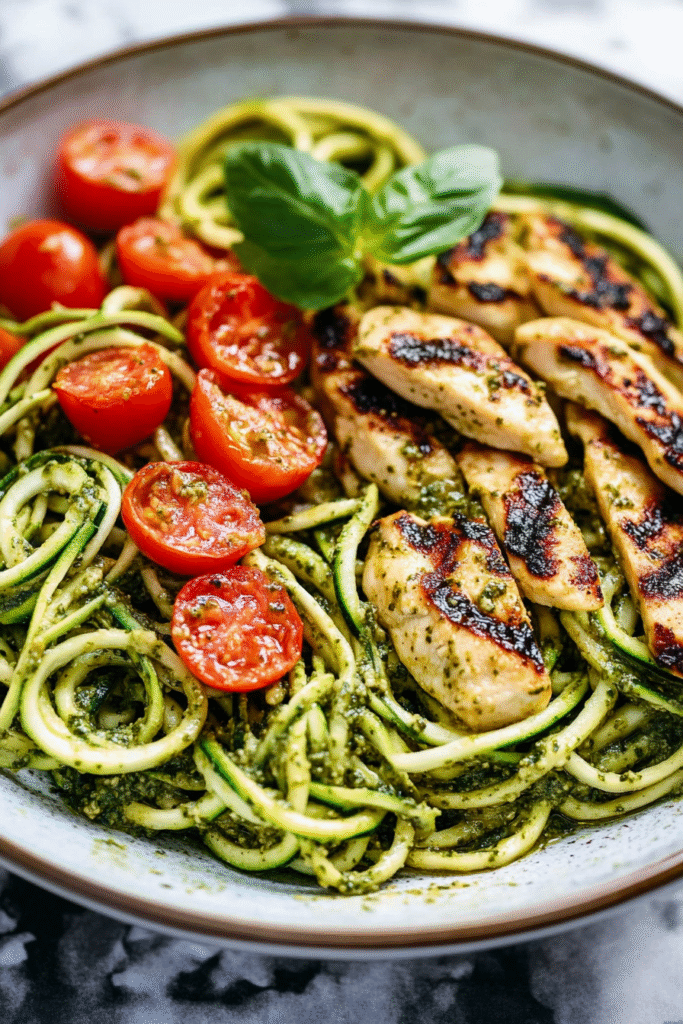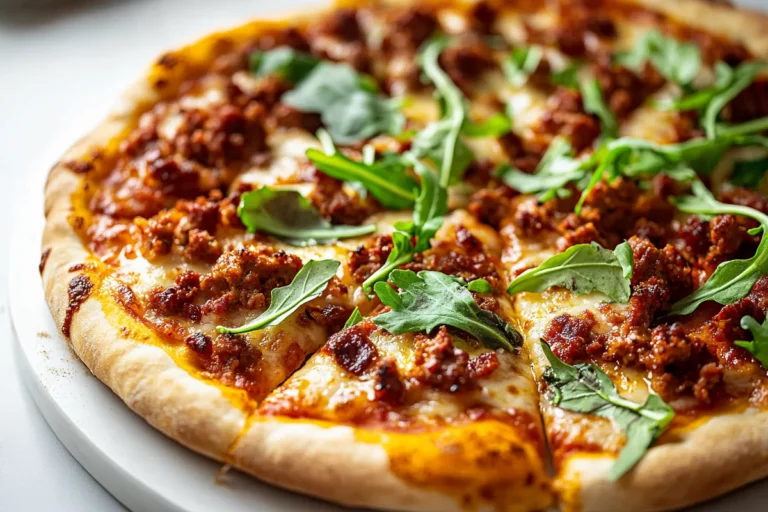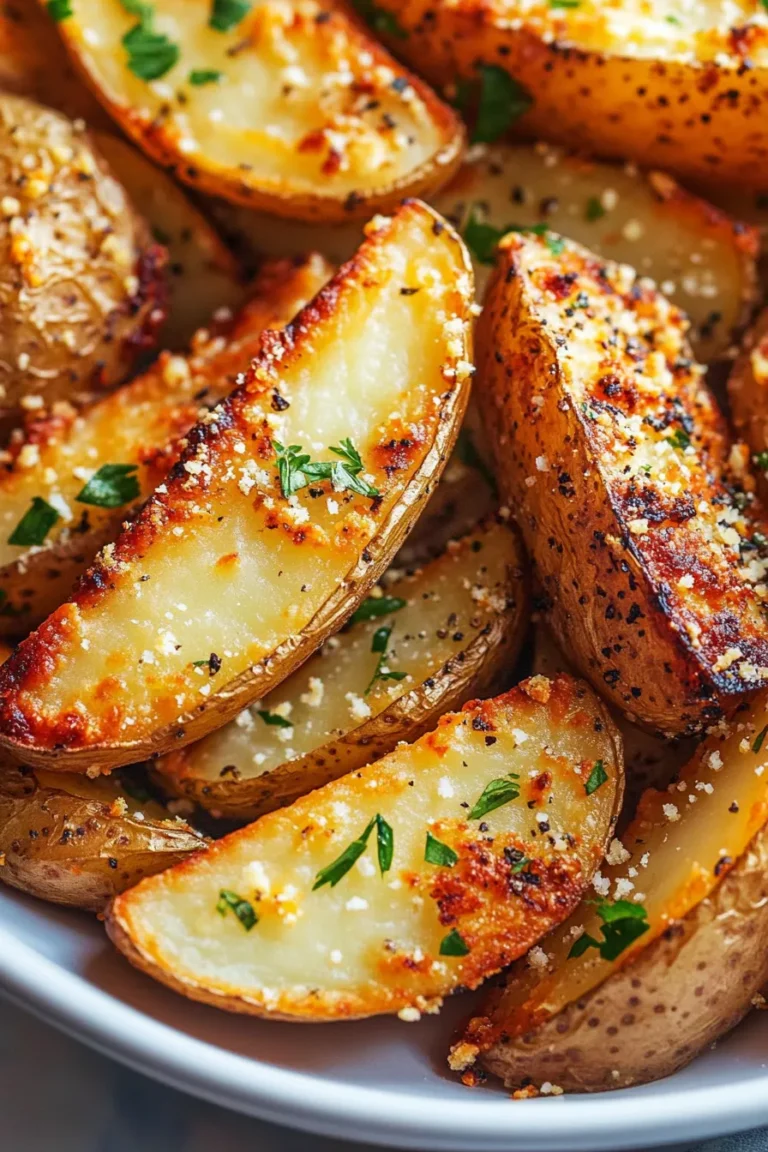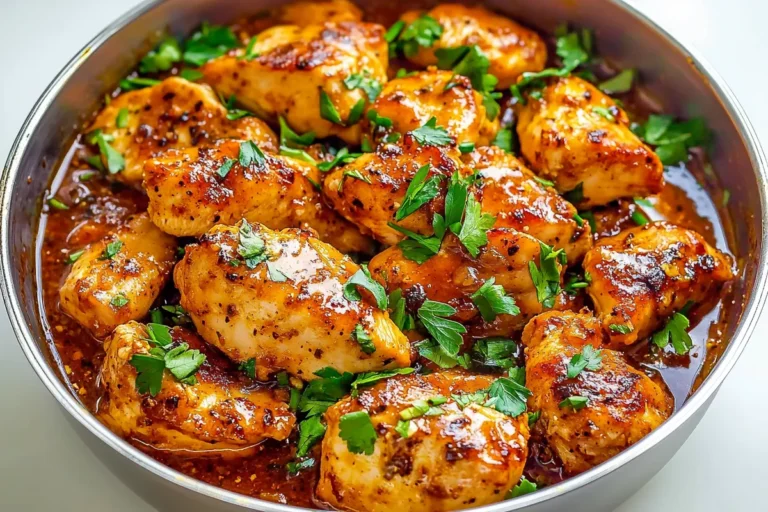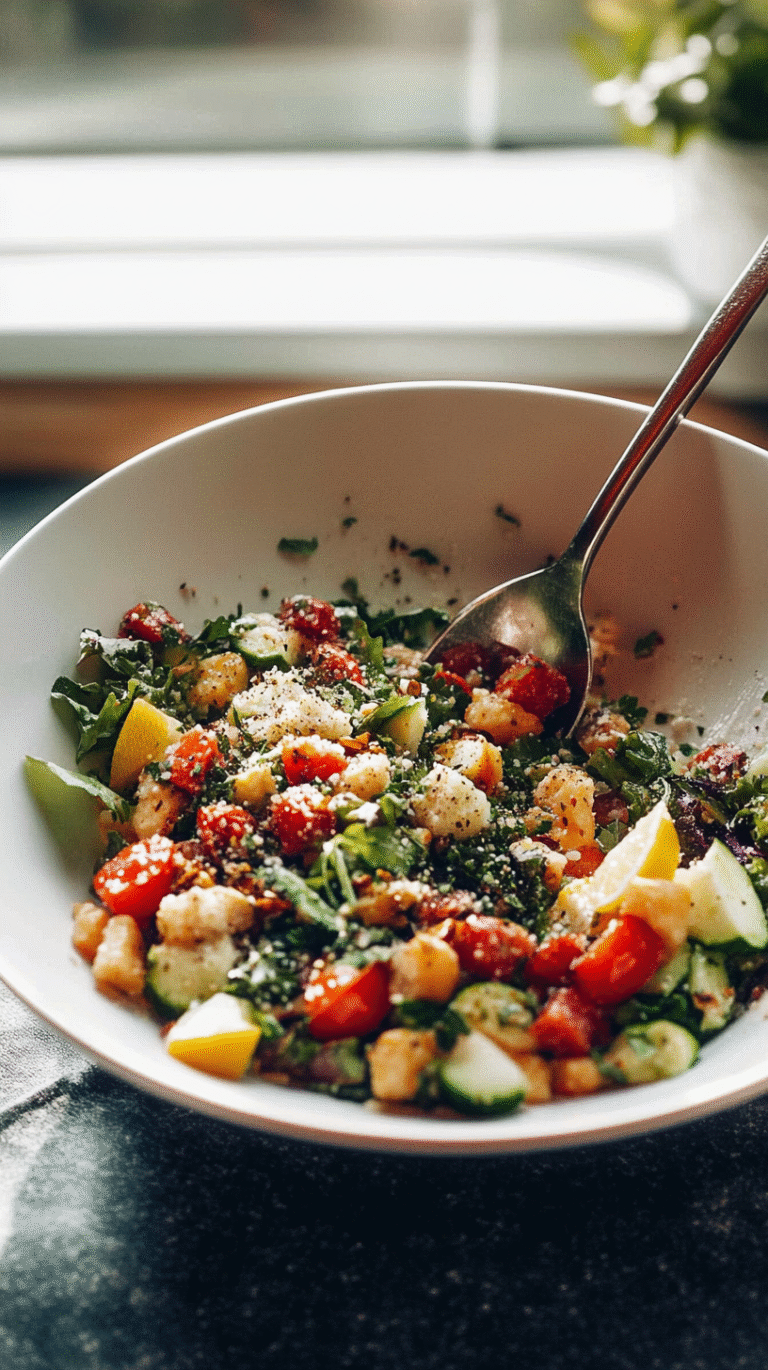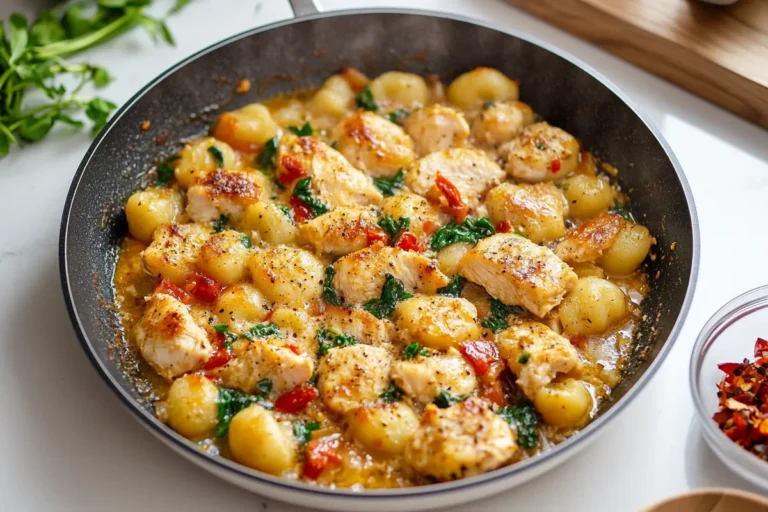Zucchini Noodles with Pesto – The Best Healthy Pasta Alternative
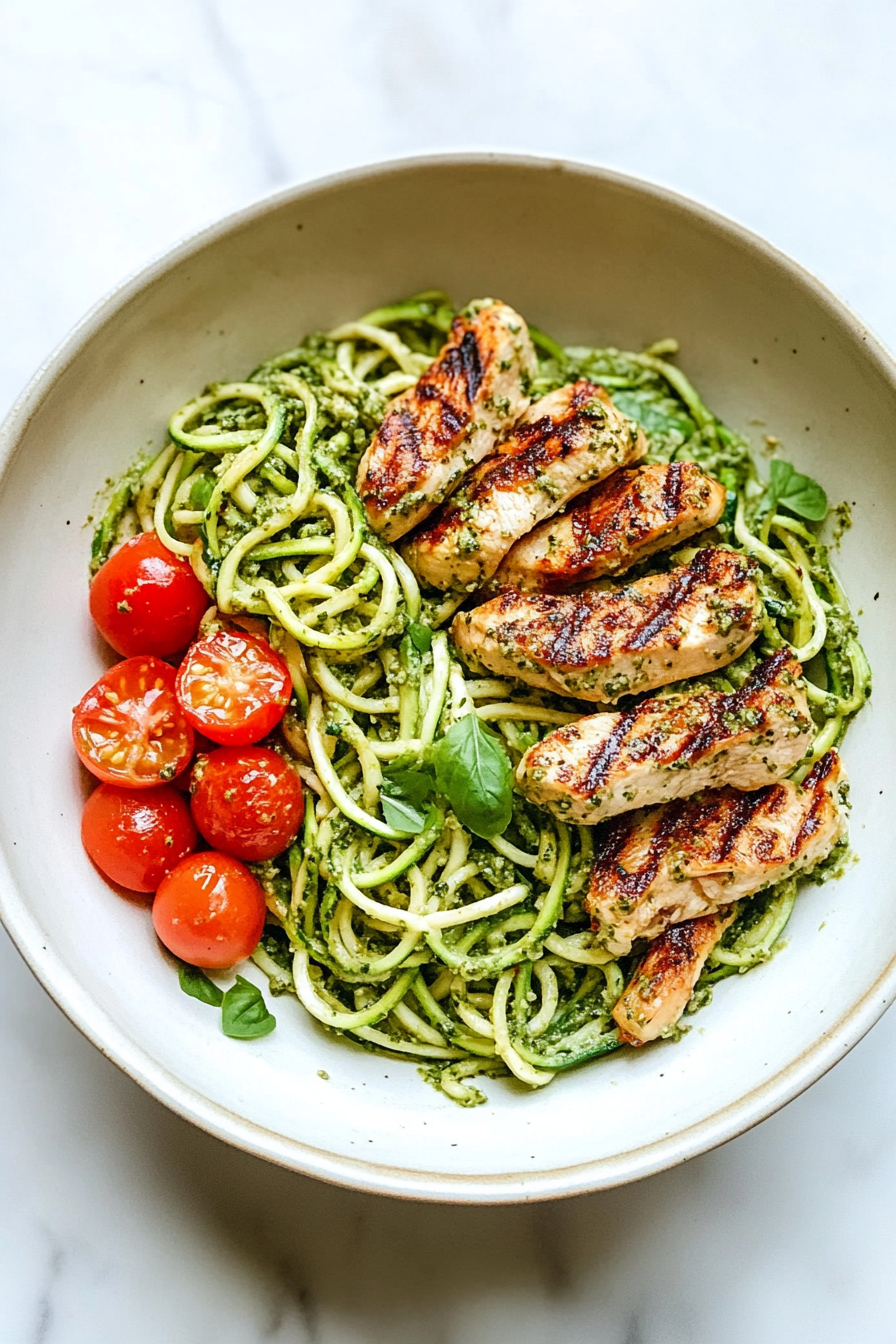
Imagine it’s a busy weeknight. You’re tired, hungry, and craving a comforting bowl of pasta—but the thought of heavy carbs, bloating, and post-dinner guilt makes you hesitate. That’s exactly where I was—until I discovered the magic of zucchini noodles with pesto.
One spiralizer, a handful of fresh basil, and a few pantry staples later, I had a dish that completely changed my dinner game. Light yet satisfying, creamy yet clean, this recipe has everything you love about traditional pasta—but without the gluten, excess calories, or regret.
Zucchini noodles with pesto are more than just a trend. They’re a smart, flavorful swap for pasta that’s loaded with nutrients, antioxidants, and fiber. When tossed with a vibrant basil and pumpkin seed pesto, these zoodles become a craveable, low-carb meal even picky eaters adore. In fact, one bowl delivers under 200 calories and packs in heart-healthy fats, vitamin C, magnesium, and immune-boosting zinc.
In this guide, you’ll not only learn how to make the perfect bowl of zucchini noodles with pesto, but also how to keep them from turning soggy, how to customize your pesto to match your mood or dietary needs, and why this dish should be a permanent fixture in your healthy meal rotation.
Whether you’re gluten-free, vegetarian, low-carb, or simply love clean, colorful food that feels indulgent without weighing you down—this recipe was made for you.
Learn more about Mediterranean flavors and fresh veggie meals in our post on 15 Easy Mediterranean Diet Recipes
What Makes Zucchini Noodles a Smart Pasta Alternative?
Zucchini noodles are trending for good reason—they’re a low-calorie, low-carb substitute for pasta that doesn’t compromise on texture or taste. When spiralized or julienned properly, zucchini offers a slightly crisp bite that mimics al dente spaghetti.
| Comparison | Traditional Pasta (1 cup) | Zucchini Noodles (1 cup) |
|---|---|---|
| Calories | 221 | 20 |
| Carbs | 43 g | 4 g |
| Fiber | 2.5 g | 1.5 g |
Beyond the macros, zucchini is rich in vitamin C, potassium, and antioxidants, making it a truly health-forward ingredient for anyone looking to cut refined carbs or increase their veggie intake.
Zoodles also accommodate various diets: they’re naturally gluten-free, vegan, paleo, and keto-friendly—making them a go-to for just about every lifestyle.
Basil-Pumpkin Seed Pesto: A Unique Take on a Classic Sauce
Health Benefits of Pepitas and Fresh Basil
One of the best things about zucchini noodles with pesto is how adaptable they are—especially when it comes to the sauce. This variation features a basil-pumpkin seed pesto, a modern spin that brings bold flavor and powerful nutrition to your plate. Whether you’re new to spiralized recipes or a zoodle pro, this pesto is what turns a bowl of veggie noodles into something crave-worthy.
Swapping out traditional pine nuts for pepitas (green pumpkin seeds) is more than a budget-friendly move—it’s a nutritional upgrade. Pepitas are high in:
- Magnesium for energy metabolism
- Zinc for immunity
- Plant-based protein to fuel you longer
- Heart-healthy fats that support overall wellness
Combine that with fresh basil, a classic herb known for its anti-inflammatory and antioxidant properties, and you’re looking at a sauce that’s not just delicious, but genuinely good for you.
Step-by-Step Instructions for Making Basil-Pepita Pesto
Ready to bring your zucchini noodles with pesto to life? Here’s how to make this vibrant, creamy sauce that clings beautifully to every twirl of zoodle.
Ingredients:
- ½ small yellow onion, roughly chopped
- 1 garlic clove, roughly chopped
- 2 cups packed fresh basil leaves (arugula works, too)
- ½ cup pepitas, toasted
- ⅓ cup olive oil
- 2 teaspoons red wine vinegar (or lemon juice)
- Pinch of red pepper flakes
- Salt, to taste
Instructions:
- Toast your pepitas in a dry pan over medium heat until lightly golden and aromatic. Set aside to cool.
- In a food processor, blend the onion, garlic, basil, toasted pepitas, olive oil, vinegar, and red pepper flakes until the texture is smooth and creamy.
- Taste and season with salt. Add more vinegar or lemon juice if the pesto feels too flat.
This pesto version is perfect for those seeking a dairy-free, vegan, and nut-free way to enjoy zucchini noodles with pesto without sacrificing flavor.
For even more veggie-forward dinner options, don’t miss our Mediterranean Stuffed Bell Peppers Recipe.
How to Make the Best Zucchini Noodles at Home
Print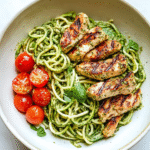
Zucchini Noodles with Pesto Recipe
- Total Time: 15 minutes
- Yield: 1 large bowl of zucchini noodles with pesto (4 servings) 1x
- Diet: Vegetarian
Description
Zucchini noodles with pesto are the best low-carb pasta swap. Easy, healthy, and packed with flavor. Try this vibrant 15-minute recipe today!
Ingredients
For Basil-Pumpkin Seed Pesto:
½ small yellow onion, roughly chopped
1 garlic clove, roughly chopped
2 cups packed fresh basil leaves (arugula works too)
½ cup toasted pepitas (green pumpkin seeds)
⅓ cup olive oil
2 teaspoons red wine vinegar (or lemon juice)
Pinch of red pepper flakes
Salt, to taste
For Zucchini Noodles:
3 large zucchini
Salt, for draining
1 pint cherry tomatoes, halved
Fresh basil leaves, for garnish
Instructions
- Make the Pesto: Toast the pepitas in a dry pan over medium heat for 3–4 minutes, until fragrant. Let cool slightly. In a food processor, combine onion, garlic, basil, toasted pepitas, olive oil, vinegar, and red pepper flakes. Blend until smooth. Season with salt to taste and set aside.
Prepare the Zoodles: Spiralize the zucchini using a spiralizer or julienne peeler. Place the zoodles in a colander, sprinkle with a bit of salt, and let them drain for 10–15 minutes. Pat dry using paper towels.
Assemble the Dish: Toss the dried zucchini noodles with the pesto in a large mixing bowl until evenly coated. Transfer to a serving platter.
Add Toppings: Scatter cherry tomatoes across the top and garnish with fresh basil leaves.
Serve: Enjoy immediately, or chill and serve cold as a refreshing summer dish.
Notes
- For a nut-free version, pepitas are an ideal substitute for pine nuts in pesto.
- To keep zoodles crisp, avoid overcooking. Raw or lightly warmed in a dry skillet works best.
- Zucchini Noodles with Pesto is great served cold or at room temperature!
- Prep Time: 10 minutes
- Cook Time: 5 minutes
- Category: Main Course, Light Lunch
- Cuisine: Mediterranean
Nutrition
- Serving Size: 4
- Calories: 197
- Sugar: 7g
- Sodium: 351mg
- Fat: 16g
- Saturated Fat: 3g
- Carbohydrates: 11g
- Fiber: 3g
- Protein: 6g
- Cholesterol: 4mg
1. Spiralizer, Peeler, or Grater: What’s the Best Method?
To make perfect zucchini noodles with pesto, your technique for creating the zoodles matters just as much as the sauce. Thankfully, there’s no one-size-fits-all approach—you’ve got options depending on the tools you have in your kitchen:
2. Assembling the Perfect Zucchini Noodles with Pesto Dish
| Tool | Texture & Look | Pros | Best Use Case |
|---|---|---|---|
| Spiralizer | Long, curly noodles | Quick, consistent | For large batches or parties |
| Julienne Peeler | Thin, straight noodles | Budget-friendly, portable | Perfect for 1-2 servings |
| Box Grater | Thick, ribbon-like | Easy and accessible | Great if you don’t own gadgets |
Pro Tip: If using a spiralizer, choose firm, fresh zucchini and trim off both ends for easier handling. Medium-sized zucchinis work best—they’re easier to grip and create uniform strands.
Whether you call them veggie noodles, zoodles, or zucchini spaghetti, the goal is to get a texture that holds up once mixed with pesto.
Tips to Avoid Soggy Zoodles Every Time
Nothing ruins zucchini noodles with pesto like mushy, watery strands. The good news? You can avoid this common pitfall with a few smart tricks:
- Salt and Sweat: After spiralizing, sprinkle a light layer of salt on the noodles. Let them sit in a colander for 10–15 minutes to draw out excess water. Pat them dry with a paper towel before tossing with pesto.
- Skip the Stove: Zoodles don’t need much cooking—especially if your pesto is warm or room temp. Instead of sautéing, try lightly tossing them raw in the sauce. The residual heat from the pesto is often enough.
- Quick Sauté (Optional): If you must cook them, do it fast—1 to 2 minutes max in a dry pan over medium heat. No oil, no crowding, and definitely no lid. You want them just warmed, not wilted.
Using these methods keeps your zucchini noodles with pesto fresh, vibrant, and ready to impress.
Looking for inspiration? Try this Mediterranean Quinoa Bowl Recipe for another clean, veggie-packed dish.
Mixing Pesto and Zoodles: How to Get Even Coating
So you’ve spiralized the zucchini and prepped your flavorful basil-pumpkin seed pesto—now it’s time to combine everything into a dish that pops with freshness.
Here’s how to do it right:
- Dry your zucchini noodles well. Moisture is the enemy of rich pesto sauce. Make sure you’ve salted and patted your zoodles dry beforehand.
- In a large bowl, add your zucchini noodles and start by tossing with half the pesto. This ensures a balanced coating without over-saturating the noodles.
- Gradually add more pesto to taste. Remember: you can always add more, but you can’t take it back.
- Gently fold the noodles using tongs or clean hands. This method prevents breakage and helps the sauce cling better to each spiral.
This gentle mixing technique ensures every strand is infused with the nutty, garlicky, and herby punch of the homemade pesto, giving your zucchini noodles with pesto that rich, cohesive flavor profile we all crave.
3. Flavor Boosters: Tomatoes, Basil Garnish & Finishing Touches
While the pesto-coated zucchini noodles shine on their own, a few thoughtful toppings can elevate the dish from “quick lunch” to “dinner-party worthy.”
Here’s what to add:
- Cherry Tomatoes: Halved or whole, these juicy gems add color, texture, and a touch of sweetness to balance the boldness of pesto.
- Fresh Basil Leaves: Tuck them into the sides of the platter or sprinkle over the top for visual appeal and fresh aroma.
- Cracked Black Pepper & Red Pepper Flakes: A little heat goes a long way in waking up the flavors.
- Olive Oil Drizzle: A final swirl of high-quality olive oil adds shine and depth.
Serving Tip: Arrange your zucchini noodles with pesto on a large platter and add toppings strategically to make it pop. Visual appeal boosts the eating experience!
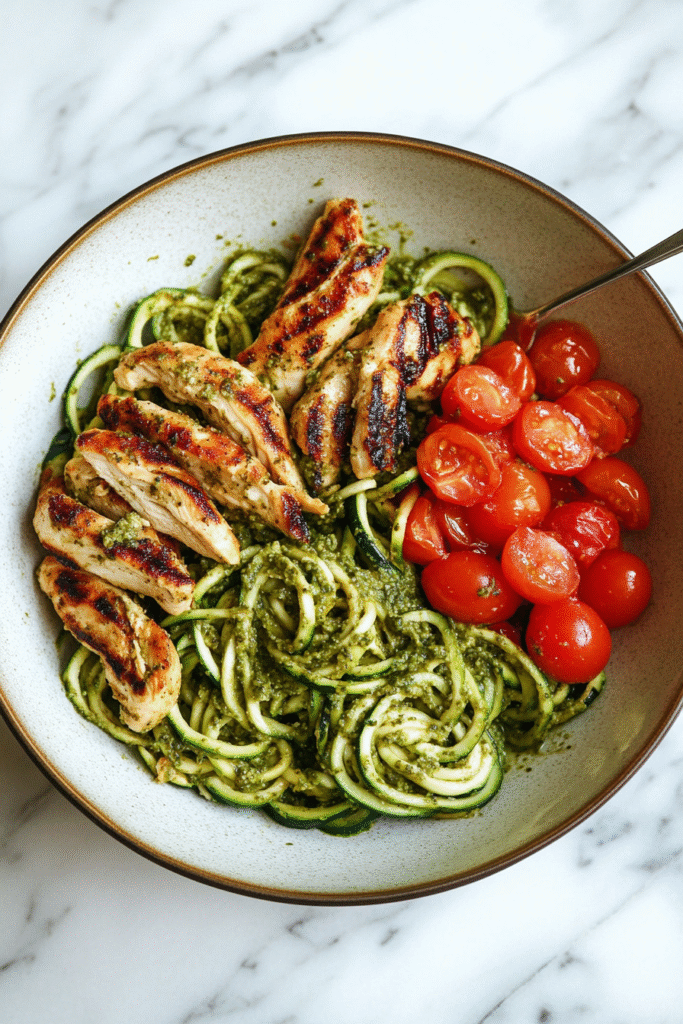
Don’t miss our Mediterranean Roasted Eggplant for a beautiful side dish to pair with this recipe.
Nutritional Breakdown and Diet Compatibility
Calorie Count and Macronutrient Profile per Serving
If you’re watching your macros or simply aiming to eat cleaner, zucchini noodles with pesto are a delicious way to stay on track. This plant-based dish is naturally gluten-free, dairy-free, and full of flavor—all with a surprisingly low calorie count.
Here’s the nutrition profile per serving (based on 4 servings total):
| Nutrient | Amount per Serving |
|---|---|
| Calories | 197 |
| Total Fat | 16 g |
| Saturated Fat | 3 g |
| Carbohydrates | 11 g |
| Sugars | 7 g |
| Fiber | 3 g |
| Protein | 6 g |
| Sodium | 351 mg |
| Cholesterol | 4 mg |
Most of the fat comes from heart-healthy olive oil and pepitas, both of which support brain and cardiovascular health. Meanwhile, the fiber content helps with digestion and satiety, making this meal both satisfying and nourishing.
Zoodles themselves are extremely low in carbs and calories, making them an excellent pasta substitute for weight-conscious eaters or anyone reducing their refined carb intake.
Is This Dish Good for Keto, Paleo, or Vegan Diets?
Yes—zucchini noodles with pesto are highly adaptable and diet-friendly. Here’s how this dish fits into popular eating styles:
- Keto: With just 11g of carbs (mostly from veggies), this dish is keto-appropriate—especially if you keep the tomato quantity modest or swap them for olives.
- Paleo: No dairy, grains, or legumes—this pesto zoodle dish is perfectly aligned with paleo principles.
- Vegan: Our recipe uses no cheese or animal products. The pumpkin seeds replace parmesan, and olive oil brings creaminess without dairy.
- Whole30: Simply verify your vinegar is compliant, and you’re good to go.
- Low-FODMAP: Swap the garlic for garlic-infused oil, and reduce onion to taste.
Whether you’re looking to slim down, avoid allergens, or just eat more plants, zucchini noodles with pesto offer flexibility without sacrificing taste.
Don’t miss our Spinach and Feta Stuffed Portobello Mushrooms for another diet-friendly, low-carb main course.
Common Mistakes and How to Avoid Them
Overcooking Zoodles and How to Fix It
One of the biggest pitfalls when making zucchini noodles with pesto is ending up with soggy, limp zoodles. Since zucchini is over 90% water, it’s incredibly easy to overcook.
Avoid these common mistakes:
- Mistake: Cooking zoodles too long
- Fix: Limit stovetop time to 1–2 minutes max—or skip cooking altogether.
- Mistake: Not salting the zoodles
- Fix: Salt and drain them beforehand to remove excess moisture.
- Mistake: Using high heat
- Fix: A medium-low heat helps preserve texture without drawing out too much water.
If you accidentally overcook them, drain off as much water as possible and top with extra pesto and crunchy toppings (like toasted pepitas) to add contrast.
Balancing Pesto Acidity and Saltiness
Homemade pesto has personality—and sometimes it’s a little too punchy. The onions, garlic, and vinegar can easily dominate if not adjusted properly.
Here’s how to fix it:
- Taste and tweak: After blending, let the pesto sit for 5 minutes. Then adjust vinegar or lemon juice to mellow sharpness.
- Add olive oil: A splash of extra virgin olive oil smooths out sharp edges and enriches the mouthfeel.
- Balance with tomatoes: The sweetness of cherry tomatoes naturally offsets any acidic or salty flavors.
Keeping these tips in mind ensures that your zucchini noodles with pesto come out perfect—every time.
What to Serve with Zucchini Noodles with Pesto
When it comes to building a balanced meal, zucchini noodles with pesto pair beautifully with a variety of dishes that complement its vibrant flavor and light texture. Whether you’re creating a dinner party menu or simply expanding your weeknight lineup, these recipes make ideal companions.
Protein-Packed Additions
If you’re turning your zucchini noodles with pesto into a main dish, consider adding a source of protein to round out the plate. These easy pairings add depth and satiety:
- Greek Salad with Lemon-Herb Dressing – Rich in antioxidants and healthy fats, it’s a testament to how the Mediterranean diet turns humble ingredients into a symphony of flavors especially with zucchini noodles with pesto.
- Shrimp Scampi Pasta – Fast and flavorful, they’re perfect over a bed of zoodles.
- Crispy Tofu Cubes – Keep it vegan without skimping on texture and protein.
- Poached Eggs – Let that yolk ooze right into your zucchini noodles with pesto for creamy richness.
Frequently Asked Questions
Is pesto good on zucchini?
Absolutely! Pesto adds a burst of herbaceous, nutty flavor that complements the mild, slightly sweet taste of zucchini. It’s one of the best ways to elevate your veggie noodle game and turn zucchini into something indulgent yet healthy.
How do you cook zoodles so they’re not soggy?
The key is to salt and drain the zoodles, then avoid overcooking. Either serve them raw tossed in warm pesto or lightly heat in a dry skillet for 1–2 minutes. Never microwave them—this causes excess moisture.
What noodles go best with pesto?
While traditional pasta like linguine or fusilli works, zucchini noodles with pesto are a low-carb, gluten-free alternative that soak up pesto beautifully while adding nutrients and fiber.
Are zucchini noodles with pesto actually healthy?
Yes! Zoodles are low in calories, high in fiber and vitamins (like C and potassium), and contain antioxidants. They’re also naturally gluten-free and keto-friendly, making them ideal for a range of diets.
Can I make zucchini noodles ahead of time?
You can spiralize the zucchini in advance and store it in the fridge (in an airtight container with a paper towel) for up to 3 days. Just be sure to keep the pesto separate until ready to serve.
What’s a good substitute for pine nuts in pesto?
Pumpkin seeds (pepitas) are a fantastic, budget-friendly substitute. They add a nutty flavor and creamy texture while being allergen-friendly and rich in minerals like zinc and magnesium.

